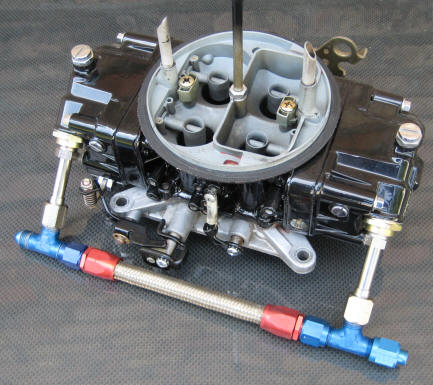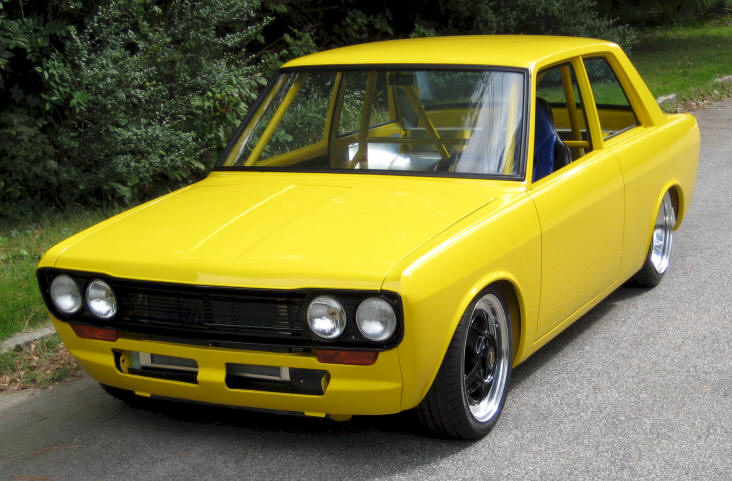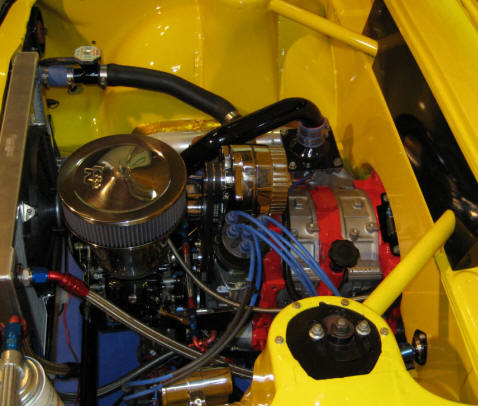Design Philosophy
My design goal for this car was simple: make the quickest possible streetable 510. That's it. Quickness is first and last, though the word streetable is in there too: it must be easy to drive on the road. Light weight "outweighs" high power, because power doesn’t help a car corner or stop. Compromises are in favor of torque versus horsepower, in acceleration versus top speed, and in cornering and braking vs. straight-line speed, since this is a street car.
This brings up an interesting point. No car can be designed or built with only one specific goal in mind. There can be a primary goals, but there are always secondary goals as well. Even in the most extreme cases, such as a Top Fuel dragster or a Formula One car, there are the secondary concerns of safety and rule compliance. Various attributes, like acceleration, ride quality, fuel efficiency, etc., are given specific priorities (or specific goals, like 0-60 MPH acceleration in seven seconds or less) at design time. Being clear on the design goals for your car can help you to decide what modifications to do next, and which ones not to do at all.
This car was built to be a show quality 510, but it was not built to be a show car. I did all of the work myself with the exception of the finishing body work and the paint. I took my time and paid careful attention to every detail throughout the process of design and construction. I enjoy fabrication and automotive work, so I had no reason to hurry.
Why did I pick a Jaguar rear suspension?
- They can be made very narrow. I wanted to run wide wheels and tires under the stock fenders (with no flares) and I couldn’t figure out a decent way to do that using the stock rear suspension.
- Everything about the Jag suspension, especially the U-joints and Dana diff, is bulletproof.
- The geometry is excellent. This is important when you’re trying to keep most of the contact patch of a 12-inch wide tire on the road during cornering.
- They have inboard disc brakes, which reduces unsprung weight and improves brake access and cooling.
- Plenty of aftermarket parts are available for Jag rear suspensions.
Why did I pick a turbocharged Mazda rotary engine?
I guess the original reason I wanted a rotary engine was to be different. But then I got to drive an RX-7 with a custom turbo setup and I was convinced. The rotary engine had too many attributes to pass up.
- Light weight is the "magic ingredient" of a performance car, the one that you can’t get enough of. It’s worth its weight in gold!? Rotary engines are very light.
- Power. I’ve heard some pretty outrageous claims of horsepower that people are getting from their turbocharged rotarys. Admittedly they may not last forever. That’s a price I am willing to pay.
- Torque. The rotary doesn’t make you pay any low-end penalties for the excellent high-end power that they produce. The power curve is very broad and the throttle response is great!
- Smoothness. Rotary owners know all about this one! You’re dealing with rotating rather than reciprocating pistons.
- Throttle response. The light rotating weight and small stroke and smoothness of the rotary makes it incredibly responsive. That makes it fun to drive!
- Small size, allowing better center of gravity (the engine sits lower in the car), better weight distribution and reduced polar moment of inertia (because the engine sits further back in the car).

Why did I use a carburetor instead of fuel injection?
This is a good question that I have heard from more than one person. The primary reason is that this car was initially designed at a time when aftermarket fuel injection and engine management systems were not nearly as accessible as they are today. But the carburetor has these benefits.
- Light weight - EFI would require many additional components and a heavier intake manifold.
- Simple and compact - minimum of hoses, wires, and components.
- Reliable - not much can go wrong with a Holley carb and a distributor.
- Maintainable - if something does go wrong, it can probably be fixed with screwdrivers.
- Good power - plenty of flow and minimal restriction with this setup.
I have always felt that this car makes plenty of power, especially considering its light weight. However, after experience with my fuel injected, twin-turbo V6 510, I have been considering upgrading this car to EFI. The problem is, I just can't think of a really good, practical reason to do it. The car would not necessarily make more power, it could be less reliable and more difficult to troubleshoot and repair, and the engine compartment would be far more cluttered.

Why didn’t I use flares?
This is another common question. No doubt overall performance could be better with flares. Cornering would be improved by a wider track width, and braking could benefit from wider front tires. But I considered these factors in deciding not to use flares:
- Running front wheels with a lot of negative offset really ruins the suspension (steering) geometry. The steering arms have to be modified to make them work decently.
- Although I have seen flared 510s that I really liked, I think 510s look best without flares.
- Fender flares, like anything else on a car, are extra weight if they are dispensable. Extra weight is best left off when possible, so that is what I did.
- Considering the light weight of this car, there is more than enough rubber in contact with the road.

